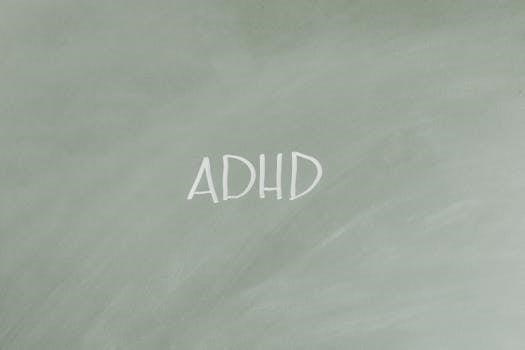adhd 2.0 pdf

ADHD 2․0, by Hallowell and Ratey, offers a new perspective on attention deficit hyperactivity disorder․ It challenges old ideas and presents a comprehensive guide for managing ADHD, emphasizing both the challenges and unique strengths associated with it․ The book highlights the importance of understanding ADHD․
Overview of the Book by Hallowell and Ratey
ADHD 2․0, penned by Drs․ Edward M․ Hallowell and John J․ Ratey, serves as a significant update to their earlier work, “Driven to Distraction․” This book offers a comprehensive exploration of ADHD, integrating the latest scientific research with the authors’ extensive clinical experience․ It aims to reshape the understanding of ADHD, moving beyond a deficit-based perspective to highlight its unique advantages․ The authors introduce new concepts, including the Variable Attention Stimulus Trait (VAST), to describe those with ADHD-like symptoms․ This book emphasizes the need for a more nuanced approach to diagnosis, treatment, and self-management of ADHD throughout one’s life․ It also focuses on strategies for creating an ADHD-friendly lifestyle and harnessing individual strengths․ Ultimately, ADHD 2․0 provides hope and practical guidance for individuals and their loved ones․
Key Concepts and Insights
ADHD 2․0 introduces several key concepts that revolutionize the understanding of ADHD․ A central theme is the idea of ADHD as a spectrum of traits, rather than a binary condition, acknowledging the wide range of experiences among individuals․ The book also emphasizes the importance of the brain’s Default Mode Network (DMN) and Task Positive Network (TPN) in understanding the neurological basis of ADHD symptoms․ Furthermore, it presents the concept of VAST (Variable Attention Stimulus Trait), which broadens the definition of ADHD-like symptoms and reduces the associated stigma․ Hallowell and Ratey also highlight the potential strengths associated with ADHD, such as creativity and hyperfocus, advocating for a strengths-based approach․ They also stress the importance of managing ADHD through lifestyle adjustments and the creation of supportive environments, rather than solely relying on medication․
Understanding ADHD 2․0
This section delves into the core of ADHD, exploring it not just as a disorder but as a spectrum of traits․ It examines the brain’s networks and introduces the VAST concept for a more inclusive understanding․
ADHD as a Spectrum of Traits
ADHD 2․0 reframes attention deficit hyperactivity disorder, moving away from a rigid diagnostic category to view it as a spectrum of traits․ This perspective acknowledges the wide variation in how ADHD manifests, recognizing that individuals experience it differently․ Rather than a binary “have it” or “don’t have it” condition, ADHD exists along a continuum, with varying degrees of challenges and strengths․ This approach is crucial because it validates the diverse experiences of people․ Some may struggle predominantly with hyperactivity, while others might have more issues with inattention․ Understanding it as a spectrum encourages personalized approaches to management, tailored to individual needs and characteristics․ The spectrum perspective emphasizes that ADHD isn’t a one-size-fits-all condition․ It helps to avoid generalizing the experience and fosters a more compassionate and accurate view of the condition․
The Role of the Brain’s Networks (DMN and TPN)
ADHD 2․0 delves into the critical roles of the brain’s Default Mode Network (DMN) and Task Positive Network (TPN) in understanding ADHD․ The DMN is active during rest and mind-wandering, while the TPN is engaged during focused attention and task execution․ In individuals with ADHD, these networks may not function as efficiently or in synchrony, contributing to difficulties with focus and task initiation․ The DMN might be excessively active, leading to distractibility, and the TPN may struggle to maintain engagement․ This imbalance can make it challenging to switch between states of rest and focused work․ Understanding the interplay between the DMN and TPN provides a neurological basis for the challenges associated with ADHD, moving beyond behavioral observations․ Recognizing these brain network dynamics is essential for developing targeted strategies and treatments to improve focus and cognitive control․
ADHD 2․0 introduces the concept of VAST, or Variable Attention Stimulus Trait, as a broader way to understand attention differences․ VAST moves beyond the traditional definition of ADHD as a disorder, framing it instead as a trait that exists on a spectrum․ This perspective acknowledges that attentional differences can be influenced by various factors, including modern life conditions, digital stimulation, and individual variations in brain function․ VAST suggests that symptoms associated with ADHD may not always be indicative of a disorder but rather a response to the demands of our environment․ By introducing VAST, Hallowell and Ratey aim to destigmatize ADHD, recognizing it as one way of experiencing the world․ This trait can manifest in various ways, with both challenges and unique strengths․ The idea of VAST encourages a more nuanced understanding of attention differences, promoting more inclusive and tailored management strategies․

Strategies for Managing ADHD
Managing ADHD involves creating an environment that minimizes challenges and maximizes strengths․ This includes establishing structure, prioritizing physical health, and utilizing strategies for focus․ The book emphasizes personalized approaches to effectively navigate daily life․
Creating an ADHD-Friendly Lifestyle
Developing an ADHD-friendly lifestyle involves understanding the unique needs and strengths associated with this condition․ It’s about crafting an environment that minimizes distractions and maximizes opportunities for success․ This includes a focus on building routines and structures that support rather than hinder natural tendencies․ Individuals with ADHD often benefit from a lifestyle that incorporates regular exercise, proper nutrition, and adequate sleep, all of which play vital roles in managing symptoms․ It also means creating physical spaces that are organized and free of clutter, as this can reduce mental overwhelm․ Furthermore, it involves finding strategies for managing time and tasks effectively․ Embracing flexibility and accepting the need for modifications is crucial․ A supportive environment that understands and accommodates the challenges of ADHD is key to thriving․ It also means being realistic about what can be achieved and celebrating small victories․ Ultimately, an ADHD-friendly lifestyle is about self-compassion and living in harmony with one’s brain․
Importance of Structure and Routine
For individuals with ADHD, structure and routine are not just helpful; they are essential for managing daily life․ The ADHD brain often struggles with organization, time management, and task initiation, making consistent routines incredibly beneficial․ A structured environment provides a framework that reduces the cognitive load and minimizes the chances of feeling overwhelmed․ Consistent schedules help create predictability, which can reduce anxiety and improve focus․ By establishing regular times for tasks such as meals, work, and rest, individuals can minimize impulsivity and improve their ability to follow through on commitments․ Routines can also help individuals with ADHD better understand the flow of their day, making it easier to plan and prioritize activities․ While the ADHD brain may resist structure initially, starting small and incorporating it gradually can lead to significant improvements in overall functioning and well-being․ A well-defined routine can be a powerful tool for creating a more balanced and productive life․
Prioritizing Physical and Mental Health
Prioritizing physical and mental health is crucial for effectively managing ADHD and enhancing overall well-being․ Physical health, through regular exercise, proper nutrition, and sufficient sleep, can have a positive impact on ADHD symptoms․ Exercise can improve focus, reduce impulsivity, and boost mood․ A balanced diet supports brain function, while adequate sleep helps to regulate emotions and improve attention․ Mental health is equally important, as individuals with ADHD often experience heightened stress, anxiety, and emotional dysregulation․ Practicing mindfulness, engaging in therapy, and seeking social support can help manage these challenges․ Taking time to engage in relaxing activities and hobbies is also vital for stress reduction․ Combining physical health practices with mental well-being strategies creates a holistic approach that can significantly improve the quality of life for individuals with ADHD․ Addressing both aspects is essential for creating a balanced and healthy lifestyle that supports the unique needs of the ADHD brain․
Practical Applications and Insights

This section explores how to utilize the strengths of ADHD, engage effectively with individuals who have it, and considers treatment options․ It also touches on the Adult ADHD Self-Report Scale as an assessment tool․
Harnessing Strengths Associated with ADHD
ADHD 2․0 emphasizes that ADHD is not solely a deficit but also a source of unique strengths․ Individuals with ADHD often possess boundless energy, creativity, and a remarkable ability to think outside the box․ These traits, when properly channeled, can lead to success in various fields․ The book suggests focusing on these strengths rather than dwelling on challenges․ It encourages individuals to identify their passions and areas where their ADHD traits can be an advantage․ This can include hyperfocus on tasks of interest, which can lead to exceptional productivity․ Furthermore, the authors highlight the importance of leveraging the spontaneous and innovative thinking that often accompanies ADHD․ By understanding and utilizing these strengths, individuals can thrive and achieve their goals․ The book also stresses that nurturing these inherent qualities is key to personal and professional success, and this is far more effective than focusing solely on the deficits․
Engaging Effectively with Individuals with ADHD

ADHD 2․0 offers valuable insights into how to interact effectively with individuals who have ADHD․ The book emphasizes that understanding the unique way their brains function is key to successful engagement․ It highlights the importance of clear, concise communication, providing specific instructions, and breaking tasks into smaller, manageable steps․ Patience and empathy are crucial, as individuals with ADHD may struggle with organization and focus․ It also underscores the significance of recognizing and addressing their strengths rather than solely concentrating on their challenges․ Creating a supportive and structured environment, free from distractions, can greatly enhance their engagement․ Encouraging their interests and finding ways to integrate them into learning or work settings is also highly beneficial․ Furthermore, the book encourages positive reinforcement and understanding the emotional sensitivities often associated with ADHD․ By employing these strategies, you can build strong and effective relationships․

Medication and Treatment Options
ADHD 2․0 explores various medication and treatment options for managing ADHD, highlighting that there isn’t a one-size-fits-all approach․ The book emphasizes the importance of a personalized treatment plan, often involving a combination of medication, therapy, and lifestyle adjustments․ It discusses different types of stimulant and non-stimulant medications, explaining how they work to improve focus and reduce impulsivity․ The book also delves into the potential side effects of medications, advocating for open communication with healthcare providers․ Furthermore, it underscores the significance of exploring other therapeutic avenues, such as cognitive behavioral therapy (CBT), which helps individuals develop coping mechanisms․ The authors also stress the role of lifestyle modifications, such as regular exercise, proper nutrition, and sufficient sleep, in supporting treatment outcomes․ The goal is to empower individuals to make informed choices about their treatment journey, aiming for optimal well-being and functioning․
The Adult ADHD Self-Report Scale (ASRS v1․1)
The Adult ADHD Self-Report Scale (ASRS v1․1), as referenced in discussions surrounding ADHD 2․0, is a crucial tool for screening adults who may have ADHD symptoms․ This self-administered questionnaire helps individuals identify potential signs of the condition, prompting them to seek further professional evaluation․ The ASRS v1․1 consists of a series of questions designed to assess inattentive and hyperactive-impulsive behaviors commonly associated with ADHD․ It’s important to note that the ASRS v1․1 is not a diagnostic tool; instead, it serves as a preliminary screening measure․ If the results indicate a high likelihood of ADHD, it’s recommended that individuals consult with a qualified healthcare professional for a comprehensive assessment․ This assessment may include interviews, behavioral observations, and additional psychological testing․ The ASRS v1;1 is a valuable resource for raising awareness about ADHD in adults, facilitating access to appropriate support and treatment options․ It’s a step towards understanding and managing symptoms, ultimately improving quality of life․